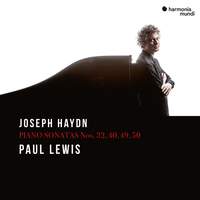Recording of the Week,
Paul Lewis performs piano sonatas by Haydn
After highly-lauded explorations of piano sonatas by Beethoven and Schubert in recent years, Paul Lewis has now turned his attention to the sonatas of Haydn, the first disc of which has just been released. As Lewis himself says: “I've wanted to explore the piano sonatas of Haydn in detail for some time. It's unfortunate that his works don't get played as often as they deserve, as they contain some of the most startlingly original and irresistibly absurd piano writing in the entire repertoire. There aren't many composers whose music can raise a laugh from an audience, but Haydn certainly tops that short list. His outrageous ability to surprise, shock, and poke fun at the listener still feels remarkably fresh in an age when ever-increasing extremes have become the norm.”
 That humour is very much on display in the four sonatas recorded here; often, the music will find itself in the “wrong” key or on an unexpected chord that brings the movement grinding to a halt. It is these aspects that Lewis is so good at bringing out, making the most of the pauses and hesitant restarts in the first movement of the Sonata in E flat major, Hob.XVI:49, or the harmonic twists and turns of the third movement of the Sonata in C major, Hob. XVI:50. Lewis has clearly thought hard about the overall shape and direction of each movement, and he is very successful at, for example, introducing a tiny amount of rubato in order to play up some of the unusual moments or to underline the structure of the piece.
That humour is very much on display in the four sonatas recorded here; often, the music will find itself in the “wrong” key or on an unexpected chord that brings the movement grinding to a halt. It is these aspects that Lewis is so good at bringing out, making the most of the pauses and hesitant restarts in the first movement of the Sonata in E flat major, Hob.XVI:49, or the harmonic twists and turns of the third movement of the Sonata in C major, Hob. XVI:50. Lewis has clearly thought hard about the overall shape and direction of each movement, and he is very successful at, for example, introducing a tiny amount of rubato in order to play up some of the unusual moments or to underline the structure of the piece.
It's not just harmonically that Haydn is often daring in these pieces, however. In Sonata 50 there are passages marked with the instruction “open pedal” plus a wavy line. Although there is some debate about whether this should be the sustaining pedal or the soft, una corda pedal (it has been suggested that Haydn was trying to imitate the tonal qualities of the Broadwood instruments he had heard on his trip to London a couple of years before writing this sonata), suffice it to say that Lewis’s approach is thoughtful as ever: he creates an ethereal, resonant sound for these moments that is quite startling. Although Lewis does perform on a modern instrument, he often brings such delicacy as if he were indeed performing on a period fortepiano, particularly with the opening of the Sonata in B minor, Hob. XVI:32, where he uses all of the ornate ornamentation to accentuate the stately, Baroque-like grace of the first movement.
The range of colours that he draws from the piano is a constant marvel, from the clarity and attack of the virtuosic flourishes in the first movement of Sonata 50 or the last movement of the Sonata in G major, Hob. XVI:40, to the softest of touches in the delicate slow movements. In this respect, the Adagio cantabile movement of Sonata 49 is a genuine highlight; so simple on the page, Lewis injects a magic into each bar that is spellbinding, contrasting wonderfully with an almost Beethovenian intensity to some of the more turbulent passages.
Lewis takes all of the marked repeats in every sonata, even the often-omitted repeats of the second halves of movements. In the wrong hands this could have been fatal, but such is the variety of invention that Lewis brings, I was actually grateful to be given the chance to hear each section twice! The hour or so of music presented here simply flew by, which is a testament to the engaging nature of his performance. Overall, then, this is a delightful account of these four sonatas that makes me keen to hear more!
Paul Lewis (piano)
Available Formats: CD, MP3, FLAC, Hi-Res FLAC



